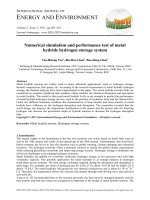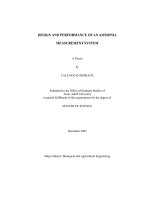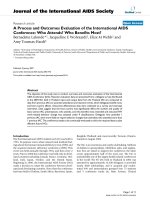Analysis, Design and Performance Evaluation of Optical Fiber potx
Bạn đang xem bản rút gọn của tài liệu. Xem và tải ngay bản đầy đủ của tài liệu tại đây (7.55 KB, 2 trang )
__________________
Abstract ii
Analysis, Design and Performance Evaluation of Optical Fiber
Spectrum-Sliced WDM Systems
by
Vivek Arya
Dr. Ira Jacobs, Chairman
Electrical Engineering
ABSTRACT
This dissertation investigates the design and performance issues of a recently demonstrated technique,
termed as spectrum-slicing, for implementing wavelength-division-multiplexing (WDM) in optical
fiber systems. Conventional WDM systems employ laser diodes operating at discrete wavelengths as
carriers for the different data channels that are to be multiplexed. Spectrum-slicing provides an
attractive low-cost alternative to the use of multiple coherent lasers for such WDM applications by
utilizing spectral slices of a broadband noise source for the different data channels. The principal
broadband noise source considered is the amplified spontaneous emission (ASE) noise from an
optical amplifier. Each slice of the spectrum is actually a burst of noise that is modulated individually
for a high capacity WDM system. The stochastic nature of the broadband source gives rise to excess
intensity noise which results in a power penalty at the receiver. One way to minimize this penalty, as
proposed and analyzed for the first time in this work, is to use an optical preamplifier receiver.
It is shown that when an optical preamplifier receiver is used, there exists an optimum filter
bandwidth which optimizes the detection sensitivity (minimizes the average number of photons/bit) for
a given error probability. Moreover the evaluated detection sensitivity represents an order of
magnitude ( > 10 dB) improvement over conventional PIN receiver-based detection techniques for
such spectrum-sliced communication systems. The optimum is a consequence of signal energy
fluctuations dominating at low values of the signal time bandwidth product (m), and the preamplifier
ASE noise dominating at high values of m. Operation at the optimum bandwidth renders the channel
error probability to be a strong function of the optical bandwidth, thus providing motivation for the use
__________________
Abstract iii
of forward error correction coding (FEC). System capacity (for BER =
10
−12
) is shown to be 23 Gb/s
without coding, and 75 Gb/s with a (255,239) Reed Solomon code.
The effect of non-rectangular spectra on receiver sensitivity is investigated for both OOK and
FSK transmission, assuming the system (de)multiplexer filters to be N’th order Butterworth bandpass.
Although narrower filters are recommended for improving power budget, it is shown that system
penalty due to filter shape may be kept < 1 dB by employing filters with N > 2. Moreover spectrum-
sliced FSK systems using optical preamplifier receivers are shown, for the first time, to perform better
in a peak optical power limited environment. Performance-optimized spectrum-sliced WDM systems
have potential use in both local loop and long-distance fiber communication systems which require
low-cost WDM equipment for high data rate applications.









